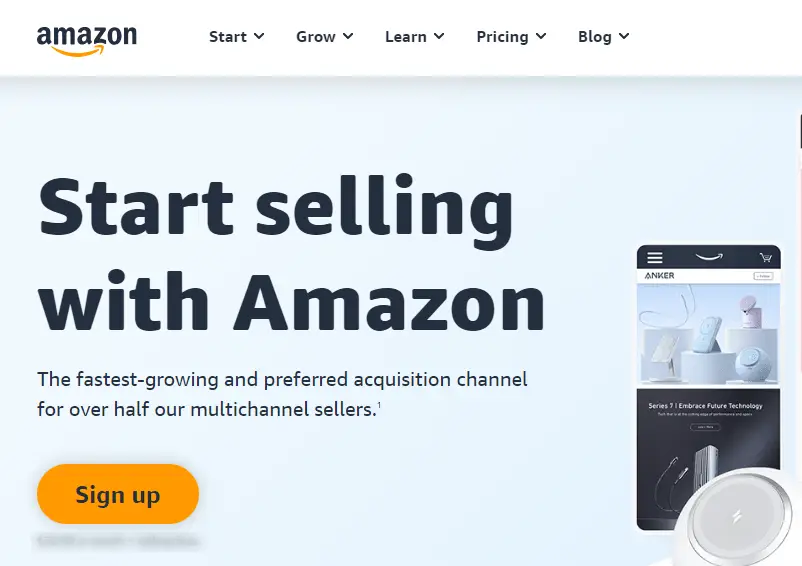Selling products online has become a popular choice for many businesses, and Amazon is undoubtedly one of the leading platforms in the e-commerce industry. With its vast customer base and extensive reach, selling on Amazon can offer numerous benefits for sellers. However, like any business venture, there are also some drawbacks to consider. In this article, we will discuss about how to sell on Amazon and the Pros and Cons of Selling on Amazon.
Pros of Selling on Amazon
1. Wide Customer Base
One of the biggest advantages of selling on Amazon is the access to a massive customer base, no doubt about that. As per media reports, Amazon has over 310 Million active users globally. With millions of active shoppers visiting the platform daily, your products have the potential to reach a much larger audience compared to selling on your own website or other marketplaces. This increased exposure can lead to higher sales and revenue for your business.
2. Fulfillment by Amazon (FBA)
Amazon offers a service called Fulfillment by Amazon (FBA), which allows sellers to store their inventory in Amazon’s fulfillment centers. This means that Amazon takes care of the packaging, shipping, and customer service for your products. Utilizing FBA can save you time and effort, allowing you to focus on other aspects of your business while Amazon handles the logistics.
3. Trust and Credibility
Amazon has built a reputation as a trusted and reliable online marketplace. Many customers feel more comfortable making purchases on Amazon due to its robust customer reviews system and reliable return policies. By selling on Amazon, you can leverage this trust and credibility to gain the confidence of potential buyers, especially if you are a new or lesser-known brand.
4. Global Reach
Selling on Amazon gives you the opportunity to expand your business globally. Amazon operates in multiple countries, allowing you to reach customers around the world without the need for extensive international shipping infrastructure. This global reach can open up new markets and increase your sales potential.
5. Marketing and Advertising Tools
Amazon provides various marketing and advertising tools to help sellers promote their products. These tools include sponsored product ads, display ads, and enhanced brand content. By utilizing these features, you can increase the visibility of your products and attract more customers.
Cons of Selling on Amazon
1. Competition
With millions of sellers on Amazon, competition can be intense, especially in popular product categories. It can be challenging to stand out among the crowd and gain visibility for your products. Additionally, Amazon may also sell its own products, which can directly compete with yours.
2. Fees and Commissions
While selling on Amazon can provide access to a large customer base, it comes with fees and commissions. Amazon charges various fees, including referral fees, fulfillment fees (if you use FBA), and monthly subscription fees for professional sellers.
These costs can eat into your profit margins, especially for low-priced products.
3. Limited Brand Control
When selling on Amazon, you have limited control over the branding and customer experience. Your product listings may appear alongside competitors’ listings, making it challenging to differentiate your brand. Additionally, Amazon’s policies and guidelines may restrict certain branding elements or marketing strategies.
4. Dependency on Amazon
By selling exclusively on Amazon, you become dependent on the platform for your sales. Any changes in Amazon’s policies or algorithms can significantly impact your business.
Therefore, it’s essential to diversify your sales channels to reduce the risk of relying solely on Amazon. You can also own a business website and sell on your own website also, sell locally etc.
How to sell on Amazon – steps for creating a Seller Account on Amazon
Step 1: Register for a Seller Account
- Visit Amazon website, and sign up for seller account on Amazon
- Sell on Amazon.com (global link)
- Sell on Amazon.in (India link)
- Visit your local country Amazon website, and scroll to the bottom of the page and click on “Sell on Amazon“.
- Click on the “Register Now” / “Sign Up” button.
- Sign in with your Amazon Account of create a new Account if you do not have one.You will be prompted to provide your business information, personal information, bank account details etc. This step primarily includes:
- Business Information
- Seller Information
- Billing Information
- Store details
The sign up process is simple. You just have to following the instructions and provide the required details.

Step 2: Choose a Selling Plan
Amazon offers two selling plans: Individual and Professional.
The Individual plan is suitable for sellers with a limited number of products, while the Professional plan is ideal for those planning to sell in large volumes. Select the plan that best suits your business needs.
Step 3: Product Category Selection
Choose the product categories you want to sell in. Amazon has specific requirements for certain categories, such as approval processes or additional fees. Ensure that you comply with all the guidelines for the selected categories.
Amazon also offers Brand Registration for free which helps protect brand identity.
Step 4: Create Product Listings
Once your account is set up, you can start creating product listings.
You will be required to provided product details and accurate product descriptions, high-quality images, and competitive pricing to attract potential buyers.
Step 6: Fulfillment Method
Decide whether you want to fulfill orders yourself or use Amazon’s Fulfillment by Amazon (FBA) service. If you choose FBA, sellers would be storing their inventory in Amazon’s fulfillment centers and Amazon takes care of the packaging, shipping, and customer service for your products. This services are not free. So you can weight your options. However, opting for Amazon FBA may be more beneficial if you are a large business.
Step 7: Start Selling
Once your listings are live, you can start selling on Amazon.
Monitor your sales, customer feedback, and reviews to continuously improve your products and customer satisfaction.
Amazon provides various tools to manage your business on Amazon from product listing, to inventory to customer service. All through out, you need to comply with the Amazon Seller program polices and guidelines.
Conclusion
Selling on Amazon can be a lucrative opportunity for businesses, offering access to a vast customer base, convenient fulfillment options, and a trusted marketplace. However, it’s crucial to consider the competition, fees, and limited brand control that come with selling on Amazon.
By following the steps outlined in this article, you can create a seller account and start selling your products on Amazon effectively. Remember to diversify your sales channels and continually adapt your strategies to maximize success on this popular e-commerce platform.
For more details, watch the following tutorial by Amazon:
# how to sell on Amazon
# how to create a seller account on Amazon
# amazon seller setup

